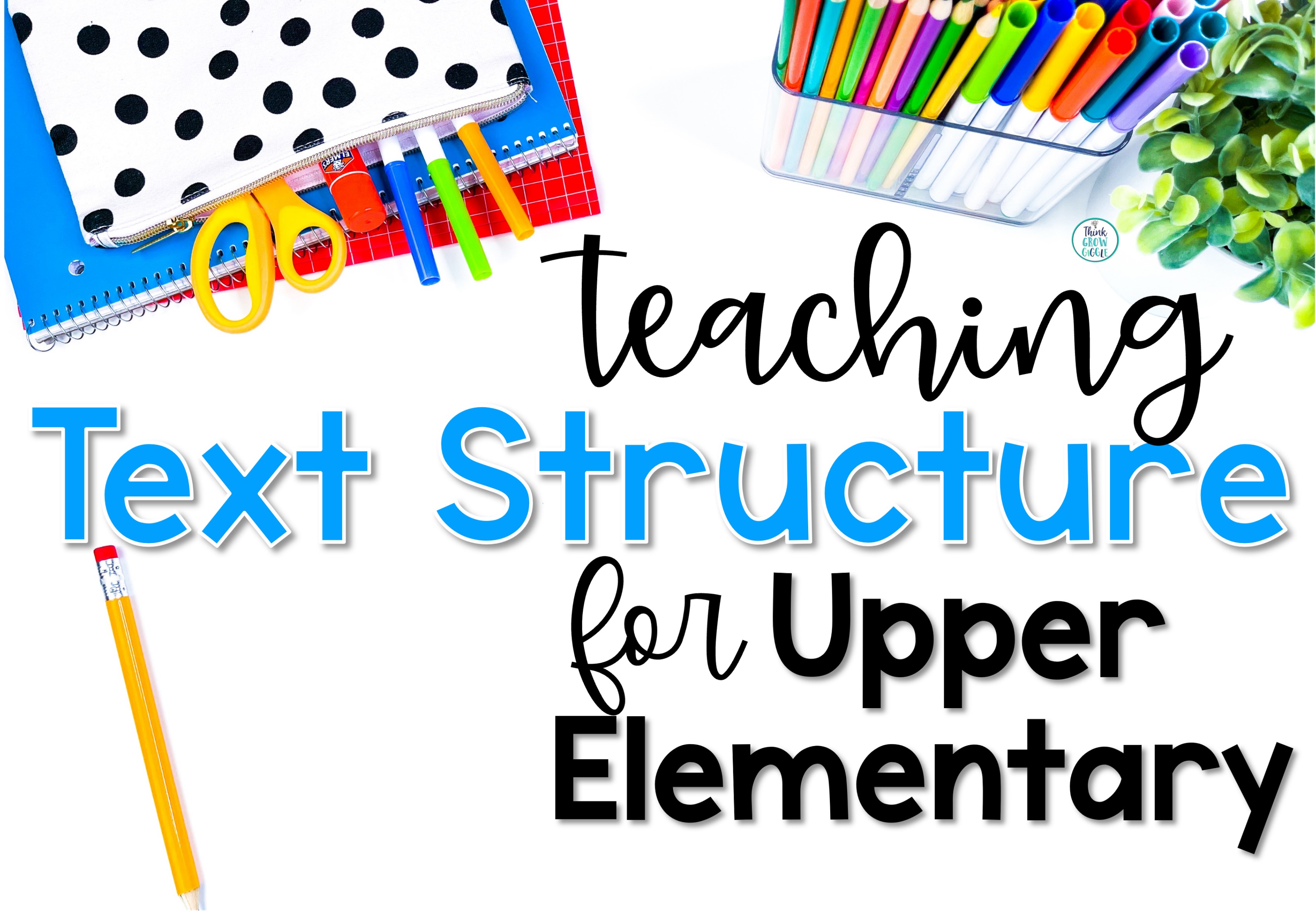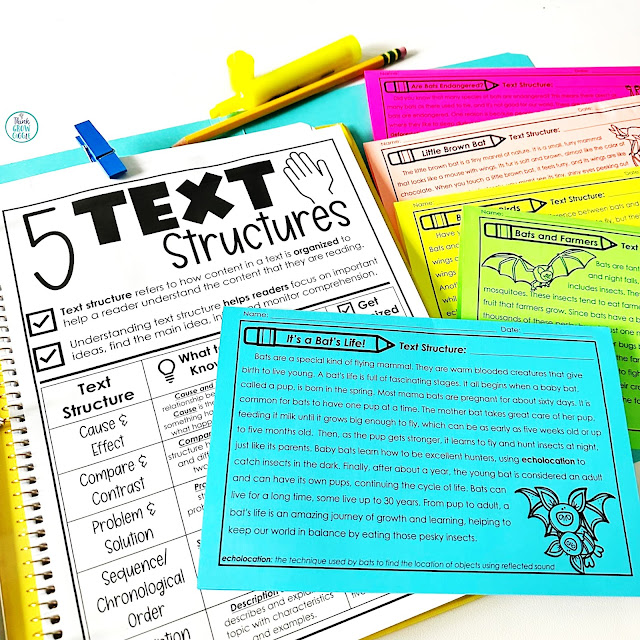When it comes to reading nonfiction material, students can never get enough practice! While many students enjoy reading nonfiction and informational articles, they often focus on the cool or new facts they learn. While that is a great way to get students engaged and excited to read nonfiction, we must ensure our upper elementary students are diving deep into the structure of informational text to help build their comprehension skills.
What is Text Structure?
Text structures refer to the way authors organize information in a text. Mastery of these structures allows students to comprehend and analyze nonfiction texts more effectively and deeply. The five key text structures our upper elementary students face are cause and effect, description, sequence, compare and contrast, and problem-solution.Understanding text structures matters! Research shows that understanding text structure is a guiding force for comprehension. According to findings from educational psychologists (e.g., Pressley & Afflerbach, 1995), explicit instruction on text structure significantly enhances students' ability to grasp the relationships between ideas and the overall comprehension of the text. It is like providing students with a roadmap showing them the way to understand the nonfiction text that they are reading.
Why Teach Text Structure?
There are so many benefits that come along with
understanding text structure as readers. When you engage your students in
nonfiction studies focused on understanding text structure, you will see...
✅Improved critical thinking -
Analyzing different text structures encourages critical thinking as
students learn to evaluate and compare information in various ways.
✅ Increase in communication skills - Mastery of text structures supports students in expressing ideas clearly, both in writing and
verbal communication.
✅ Sharpened skills for success - Proficiency in text structure is a
foundational skill that prepares students for more complex reading and writing
tasks in higher grades.
✅ Real-world Application - Recognizing text structures is not just an academic skill; it is a practical skill that students will use in different aspects of their lives, from reading news articles to understanding procedural manuals.
How to Teach Text Structure
Teaching nonfiction text structures is an important step in developing strong reading comprehension skills in upper elementary students. Try these go-to ideas for teaching text structure in your upper elementary classroom!
1. Teach Each Text Structure in Isolation
Use anchor charts and a slideshow to help teach this tricky concept! Begin
by introducing each text structure separately. This ensures that students grasp
the unique characteristics of each before moving on to more complex tasks and critical thinking about text s.
Three things to make sure that you include in your anchor charts and
introductions are:
✅Why each text structure is used
✅ Keywords that signal each text structure
✅ A visual {graphic organizer} to connect to each text
structure
Grab the FREE Text Structure Starter Kit right here!
💡Teacher tip: Use pre-written passages on the same topic, each with a different text structure! I love to use these that are focused on natural disasters!
2. Utilize Graphic Organizers as Readers and Writers
Using visual aids like graphic organizers is a great way to help students organize information and visually differentiate between the different text structures. These tools provide a clear visual representation of how information is structured in a text and helps them collect important information. When students complete the graphic organizer about a specific text, they are collecting information that will help them prove which text structure they are reading. Doing this helps them better communicate with others about their reading and convey the author's purpose and message.
3. Read Multiple Texts on the Same Topic
To deepen understanding, have students read five short texts on the same topic, each utilizing a different text structure. This activity
enables them to compare and contrast how information is presented and identify
the distinctive features of each structure. Students will collect a lot of information about one topic and show students that the longer informational books and passages they read can have more than one text structure within them.
💡Teacher Tip: Go one step further and have students respond to a prompt and write about what they learned about the given topic to synthesize their learning!
4. Real-World Sorting Activity
This is a fun way to kick off a text structure unit or wrap one up!
Encourage students to collect reading materials from the real world,
such as newspaper articles, brochures, directions, ads, informational pamphlets, and really anything! I always have a stash ready to show students how to sort the reading material. I use hula hoops to sort each text
structure, but you can use chart paper or just a table to group the reading materials. The concept is simple,
just label each hula hoop with each text structure. Then, share reading material like directions to a game. Have students decide which text structure
it was written in through discussion and debate. Then, select a student to put the
directions read into the matching hula hoop! This hands-on activity
connects classroom learning with real-world reading, and the kids love it!
5. Create Collaborative Projects
Foster collaborative learning by assigning projects where students work together to create a presentation or report using a specific text structure. This not only reinforces individual understanding but also promotes teamwork and communication skills. We have done collaborative class projects for text structure on one topic, such as Earth Day. Each group was assigned a text structure. Then, they worked together to develop a presentation for the class on an Earth Day-related topic in the assigned structure.
Here is what the kids came up with:
- Compare and Contrast: Solar Energy VS Electricity
- Sequence Order: The Process of Recycling
- Description: Enjoy Visiting a National Park on Earth Day
- Problem and Solution: Reduce, Reuse, Recycle
- Cause and Effect: Save the Mountain Gorillas from Extinction
Teaching nonfiction text structures is a fundamental step in developing strong reading and comprehension skills in upper elementary students. By focusing on cause and effect, description, sequence, compare and contrast, and problem-solution structures, we can help strengthen our students' understanding of informational texts. Implementing these tips will make the learning process engaging and empower students with essential skills for academic and real-world success. Plus, research shows that understanding text structure helps students succeed as readers of nonfiction texts, so get started with some of these ideas today!
You will also love to read:
Nonfiction Teaching Ideas and Strategies to Hook Upper Elementary Readers




















